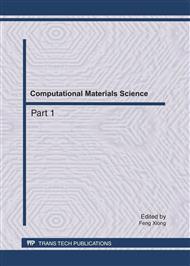[1]
H. –S. Nam, N.M. Hawang, B.D. Yu, and J. –K. Yoon: Phys. Rev. Lett. Vol. 89 (2002), p.275502.
Google Scholar
[2]
G.A. Breaus, C.M. Neal, B. Cao, and M.F. Jarrold: Phys. Rev. Lett. Vol. 94 (2005), p.173401.
Google Scholar
[3]
J. –X Yang, C. –F. Wei, and J.J. G: Physica B Vol. 405 (2010), p.4892.
Google Scholar
[4]
Y. Suzuki, and K. Yamashita: Chem. Phys. Lett. Vol. 486 (2010), p.48.
Google Scholar
[5]
F. Baletto, A. Rapallo, G. Rossi, and R. Ferrando: Phys. Rev. B Vol. 69 (2004), p.235421.
Google Scholar
[6]
F. Erocolessi, W. Andreoni, and E. Tosatti: Phys. Rev. Lett. Vol. 66 (1991), p.911.
Google Scholar
[7]
T.P. Martin: Phys. Rep. Vol. 273 (1996), p.199.
Google Scholar
[8]
L.D. Marks: Rep. Prog. Phys. Vol. 57 (1994), p.603.
Google Scholar
[9]
W. de Heer: Rev. Mod. Phys. Vol. 65 (1993), p.611.
Google Scholar
[10]
J.A. Reyes-Nava, I.L. Garzo´n, and K. Michaelian: Phys. Rev. B Vol. 67 (2003), p.165401.
Google Scholar
[11]
S.M. Foiles, M.I. Baskes, and M.S. Daw: Phys. Rev. B Vol. 33 (1986), p.7983.
Google Scholar
[12]
V.G. Grigoryan, D. Alamanova, and M. Springborg: Phys. Rev. B Vol. 73 (2006), p.115415.
Google Scholar
[13]
M. Schmidt, R. Kusche, B. V. Issendorff, H. Haberland, Nature 393 (1998) 238.
Google Scholar
[14]
F. Baletto, and R. Ferrando: Rev. Mod. Phys. Vol. 77 (2005), p.371.
Google Scholar
[15]
F. Delogu: Phys. Rev. B Vol. 72 (2005), p.205418.
Google Scholar
[16]
A.A. Shvartsburg, and M. F. Jarrold: Phys. Rev. Lett. Vol. 85 (2000), p.2530.
Google Scholar
[17]
J. Pawlow: Surf. Sci. Vol. 106, (1981) p.1.
Google Scholar
[18]
D.D. Frantz: J. Chem. Phys. 115 (2001) 6136.
Google Scholar
[19]
H. Haberland, T. Hippler, J. Donges, O. Kostko, M. Schmidt, and B.V. Issendorf: Phys. Rev. Lett. Vol. 94 (2005) p.035701.
Google Scholar
[20]
M. Schmidt, R. Kusche, T. Hippler, J. Donges, W. Kronmüller: B. V. Issendorff, and H. Haberland: Phys. Rev. Lett. Vol. 86 (2001), p.1191.
DOI: 10.1103/physrevlett.86.1191
Google Scholar
[21]
J.A. Reyes-Nava, L. Garzón, and K. Michaelian: Phys. Rev. B Vol. 67 (2003), p.165401.
Google Scholar


